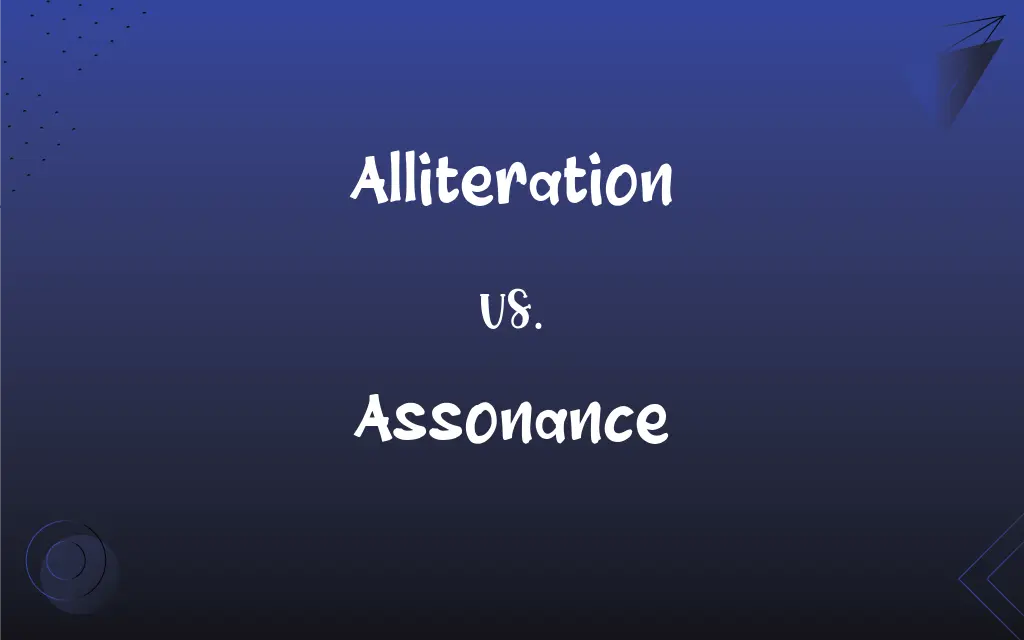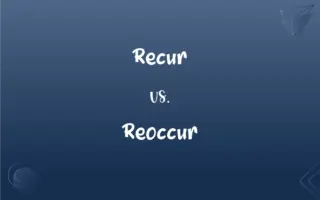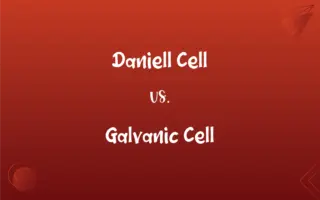Alliteration vs. Assonance: What's the Difference?
Edited by Janet White || By Harlon Moss || Updated on October 22, 2023
Alliteration involves repeated initial consonant sounds; assonance focuses on repeated vowel sounds within words.

Key Differences
Alliteration is a poetic device characterized by the repetition of the same initial consonant sounds in words close to one another. Assonance, on the other hand, deals with the repetition of similar or identical vowel sounds within words, especially in the middle or end of words.
Alliteration often gives a rhythmic quality to lines of text, making them memorable or drawing attention to certain words. Assonance, conversely, provides a musical or tonal quality to poetry or prose, creating internal rhyme and echoing sounds that might evoke emotion or mood.
It's not uncommon to find both alliteration and assonance in the same line or stanza of poetry. While they have their distinct characteristics, they can work together to enhance the overall sound and feel of a piece. Still, it's crucial to recognize the distinction between the two.
In everyday language or prose, subtle use of alliteration can make phrases catchy or more memorable. Think of brand names or slogans. Assonance, though less commonly noticed in daily speech, can give a lyrical quality to lines, making them flow more smoothly.
One key distinction is where you find the repetition: alliteration is at the beginning of words, while assonance can be anywhere within them. This makes alliteration more immediately noticeable, while assonance might require a more attentive ear to detect.
ADVERTISEMENT
Comparison Chart
Definition
Repetition of initial consonant sounds
Repetition of vowel sounds within words
Purpose
Provides rhythm and makes lines memorable
Adds a musical or tonal quality to text
Placement in Words
At the beginning
Anywhere, especially middle or end
Example
"Peter Piper picked..."
"Hear the mellow wedding bells"
Occurrence in Everyday Use
Often seen in brand names, slogans, titles
Less common, more prevalent in poetry
ADVERTISEMENT
Alliteration and Assonance Definitions
Alliteration
A stylistic device making lines catchy or memorable.
Wild and woolly weather.
Assonance
Used to create internal rhyming in lines of text.
The beam gleams in the fleeting evening.
Alliteration
Repetition of initial consonant sounds in closely situated words.
She sells sea shells.
Assonance
The repetition of similar vowel sounds within words.
The rain in Spain stays mainly in the plain.
Alliteration
Found in many proverbs or idiomatic expressions.
Look before you leap.
Assonance
Commonly paired with consonance in poetry.
Bright light in the silent night.
Alliteration
A technique used to emphasize and link words together.
Big brown bear.
Assonance
A tool for setting mood or tone in poetry.
Hear the loud alarum bells.
Alliteration
A common feature in tongue twisters.
How much wood would a woodchuck chuck.
Assonance
Not constrained to the beginning of words.
Go and mow the lawn.
Alliteration
The repetition of identical or similar sounds at the beginning of words or in stressed syllables, as in "on scrolls of silver snowy sentences" (Hart Crane). Modern alliteration is predominantly consonantal; certain literary traditions, such as Old English verse, also alliterate using vowel sounds.
Assonance
Resemblance of sound, especially of the vowel sounds in words, as in
"that dolphin-torn, that gong-tormented sea" (William Butler Yeats).
FAQs
Do both alliteration and assonance provide rhythm to poetry?
Yes, but in different ways. Alliteration adds rhythmic quality, while assonance contributes a musical tone.
How is assonance different from alliteration?
Assonance involves repeated vowel sounds within words, while alliteration focuses on initial consonant sounds.
Can a line of poetry contain both alliteration and assonance?
Yes, a line can incorporate both poetic devices.
Is alliteration common in brand names?
Yes, many brand names use alliteration to be catchy and memorable.
What's a famous example of alliteration?
"Peter Piper picked a peck of pickled peppers."
Are alliteration and assonance considered rhyming techniques?
They're related to rhyme, but they don't involve matching end sounds of words like end rhyme.
How prevalent is assonance in pop songs?
Quite prevalent. Songwriters use assonance to create catchy lyrics and melodies.
What's an example of assonance in literature?
"Do not go gentle into that good night."
Can prose contain alliteration?
Yes, prose can use alliteration for emphasis or stylistic flair.
Can alliteration help in memorization?
Yes, its repetitive nature can make phrases more memorable.
What is alliteration?
Alliteration is the repetition of initial consonant sounds in closely situated words.
Which is more common in tongue twisters: alliteration or assonance?
Alliteration is more commonly featured in tongue twisters.
Can assonance occur at the beginning of words?
Yes, but it's more commonly found in the middle or end.
How do you identify assonance in a line?
Listen for repeated vowel sounds within words.
Is alliteration more about sound or meaning?
It's primarily about sound, though it can emphasize meaning.
Which poetic device is "dawn drawn dew" an example of?
It's an example of alliteration.
Are assonance and consonance the same?
No, assonance focuses on vowel sounds, while consonance deals with consonant sounds.
In what literary forms is assonance most frequently found?
It's most commonly found in poetry, but can also appear in prose and songs.
Why might a poet use alliteration in a poem's title?
To catch attention, make the title memorable, and hint at the poem's tone or theme.
Why would a writer use assonance?
Assonance can give a musical or tonal quality to a text, creating internal rhyme and mood.
About Author
Written by
Harlon MossHarlon is a seasoned quality moderator and accomplished content writer for Difference Wiki. An alumnus of the prestigious University of California, he earned his degree in Computer Science. Leveraging his academic background, Harlon brings a meticulous and informed perspective to his work, ensuring content accuracy and excellence.
Edited by
Janet WhiteJanet White has been an esteemed writer and blogger for Difference Wiki. Holding a Master's degree in Science and Medical Journalism from the prestigious Boston University, she has consistently demonstrated her expertise and passion for her field. When she's not immersed in her work, Janet relishes her time exercising, delving into a good book, and cherishing moments with friends and family.
































































